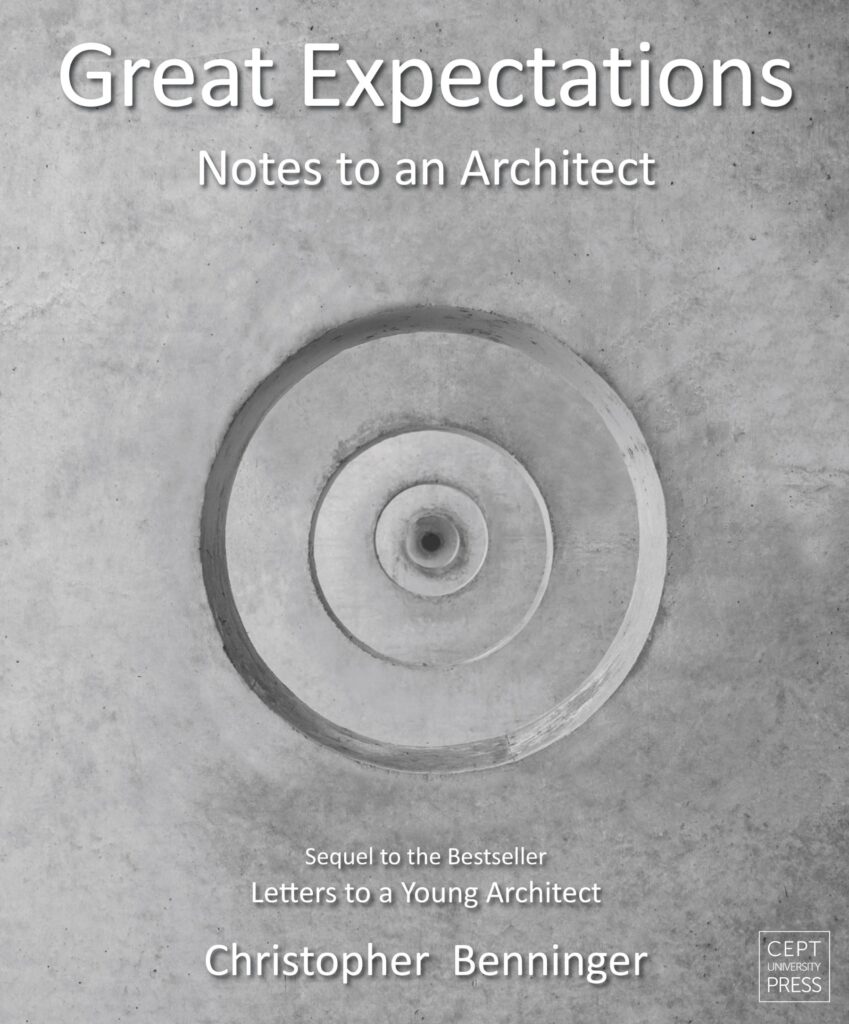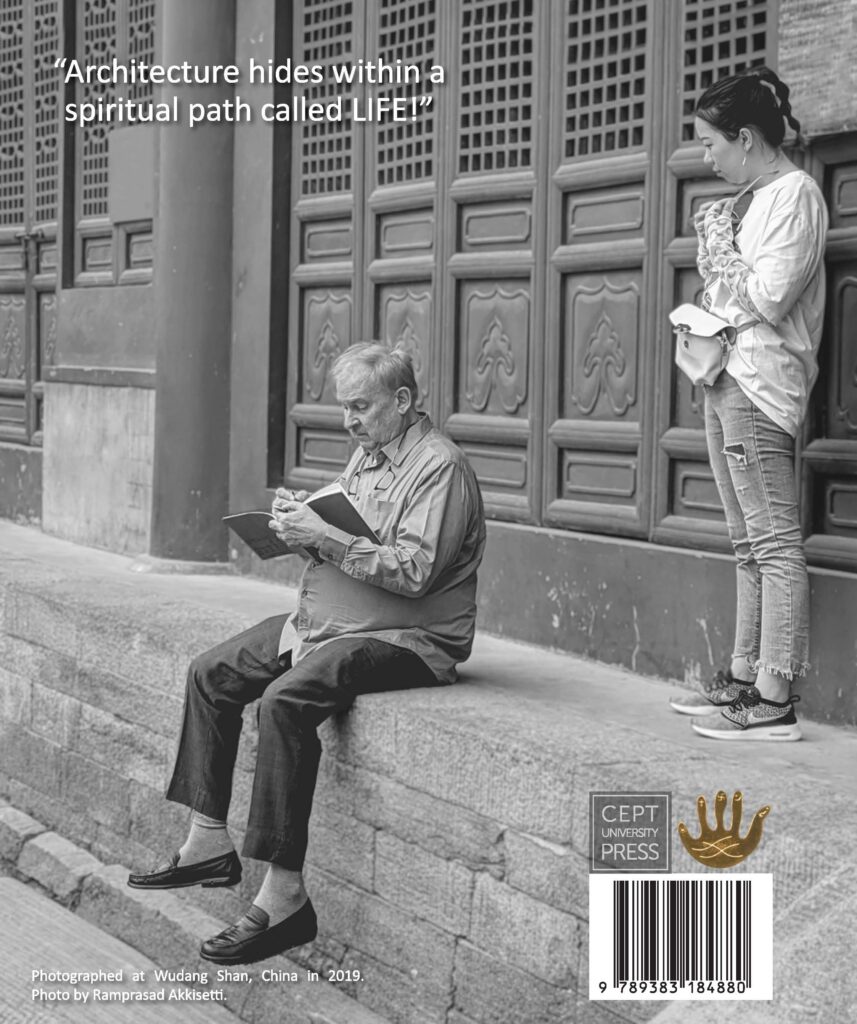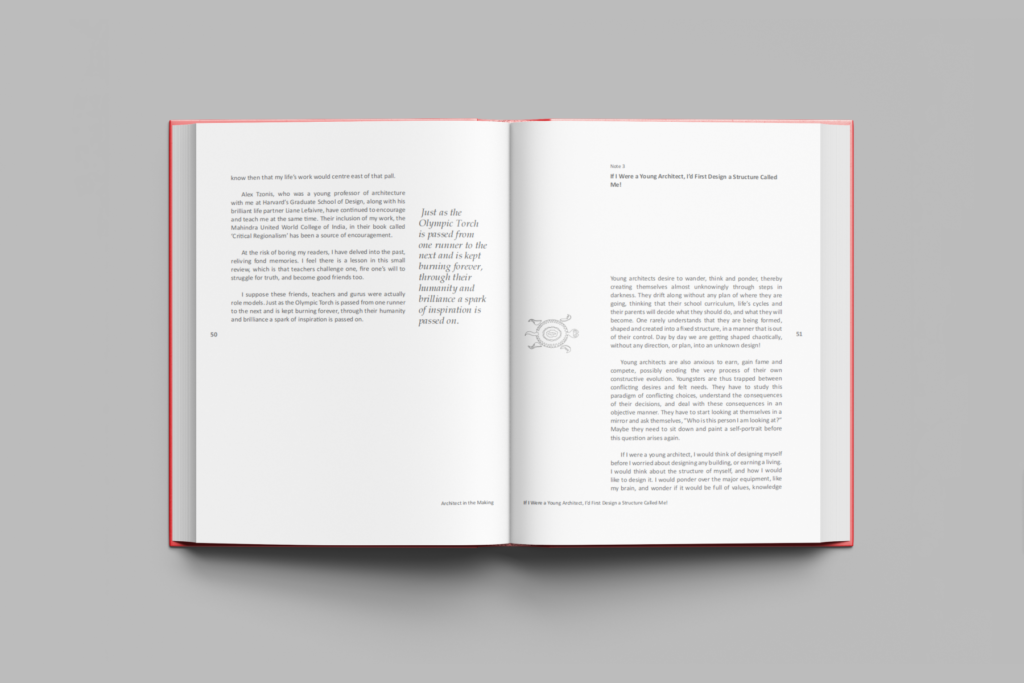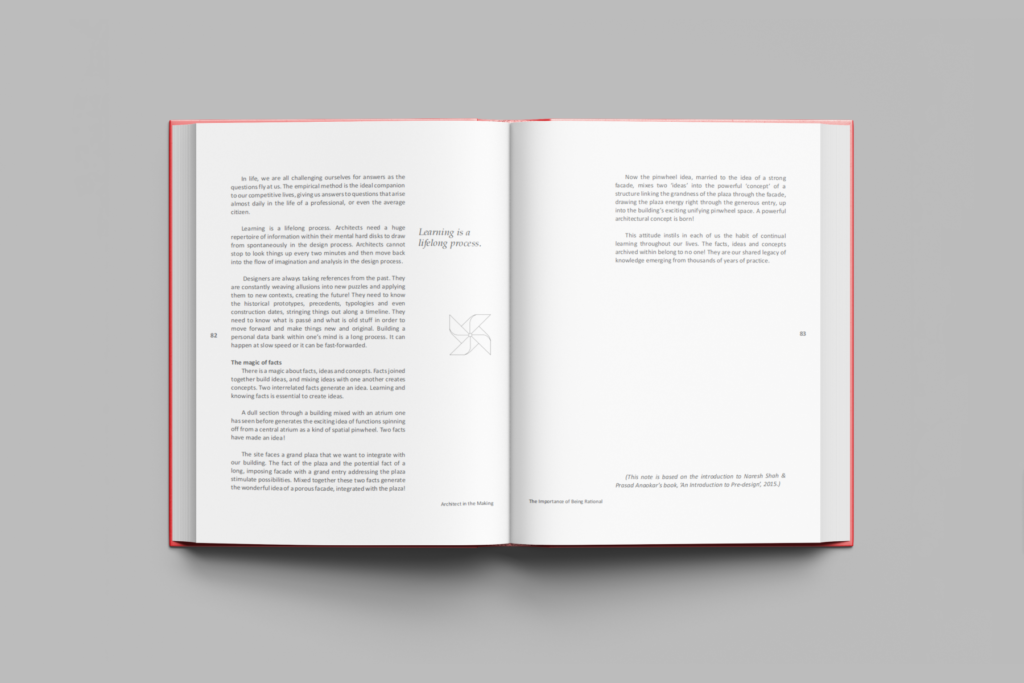
About the Book:
Professor Christopher Benninger passed away on the 2nd of October 2024. A master architect, planner, institution builder, and a teacher, he has left behind a great legacy of contextually sensitive work driven by a passion for making the world a better place. He designed many landmark institutions and iconic projects, and promoted a purpose driven view of architecture, which he saw as a social tool. He mentored generations of architects and motivated them. Professor Benninger’s contagious joy for life and passion for architecture has inspired many.
Moreover, and probably most importantly, he was a critical practitioner, often reflecting on his work and giving lectures and writing. His best-selling book, Letters to A Young Architect (2011) is a sensitive memoir of his life in India and his personal concerns about architectural theory and contemporary urban issues. His travels are not only stories of the dusty roads he travelled on, but also of the passions and emotions of those he met along the way. He notes his encounters with gurus like Jose Luis Sert, Walter Gropius, Arnold Toynbee and Buckminster Fuller and the manner in which their personal passion for humanity shaped the lives of others.

Letters to a Young Architect has been further translated into Gujarati, Chinese and Bangla in Dhaka, making it the only Indian book on architecture to be translated into other languages. Others include his monograph, Christopher Benninger: Architecture for a Modern India (2015) and contributing chapters to various books on built heritage and cultural connections
For about a year before his passing, Prof. Benninger was working on the sequel to Letters to a Young Architect, titled Great Expectations: Notes to an Architect. This book is a chronicle of his life’s journey on the path to find the spirit of architecture, replete with anecdotes and experiences from his pursuit spanning more than half a century. It captures his personal concerns about architectural education, design and practice. Like Letters, this is a collection of autobiographical narratives and ideas, presented through the medium of articles and lectures presented over the past two decades. It is his story of self-discovery and a testament to his search for truth.
Great Expectations: Notes to an Architect reflects on contemporary architectural practice and its role in improving the human condition. It gives direction to students and practitioners alike. Prof. Benninger notes his encounters with his gurus and the manner in which their personal passion for humanity shaped the lives of others. He is a firm believer in the Guru-shishya tradition, in a lineage of values, ideals, principles and practices that have matured from generation to generation. In this vein, he calls the spirit of architecture the spirit of continuity.
Prof. Benninger believes we are at a critical juncture in the evolution of architecture as a profession. He believes that the architects of today and tomorrow hold great power, and great responsibility towards creating a better world for everyone. For this, he has Great Expectations.
As a tribute to him, the book was released in Pune, his hometown on the 22nd of October 2024 in a memorial gathering for him. Furthermore, it is scheduled to be launched in Ahmedabad on 21st November, 2024 and in other cities soon.

About the Author
Christopher Charles Benninger, a luminary in the realm of architecture, has left an indelible mark on modern Indian architecture, imparting it with a unified voice and distinctive identity. With a post-graduation in urban planning from Massachusetts Institute of Technology & another in architecture from Harvard University, Prof. Benninger emigrated to India in 1971 where he co-founded the Faculty of Planning at CEPT University as a Ford Foundation advisor. He later shifted to Pune in 1976, where he founded the Center for Development Studies and Activities (CDSA). In 1995, Christopher along with Mr. Ramprasad Akkisetti started his architectural practice ‘Christopher Charles Benninger Architects’. This was renamed to CCBA Designs Pvt. Ltd. in 2005 a name under which it continues to flourish till today.
His architectural language reflects a profound sense of responsibility and unwavering appreciation for India’s cultural ethos, navigating the delicate balance between traditional knowledge systems and contemporary design language. With over 300 projects across diverse typologies spanning Institutional, Residential, Industrial, Health Care, and master planning, Benninger’s architectural excellence manifests over five decades. Pioneering sustainable architecture since 1971, his work addresses societal challenges, alleviating poverty and fostering human connections.
Education and housing stand as fundamental pillars for a burgeoning nation like India in Benninger’s advocacy for inclusivity, democracy, and superior architectural standards. His designs for over twenty institutions, including IIT Hyderabad, IIM Calcutta, and Azim Premji University, exemplify a commitment to sustainability and human-centric creations.

Professor Benninger’s impact on affordable housing is profound, influencing projects such as India’s first EWS housing scheme in Jamnagar [1972], 15,000 Site and Services housing units in Chennai funded by the World Bank [1973-78], and the EWS Yousufguda township for 2,000 families [1976-80]. His planning expertise extends globally, contributing to projects for international organizations in India, Bhutan, Nepal, Sri Lanka, Malaysia, Indonesia, Kenya, and Zambia.
Benninger’s influence transcends national boundaries, as evident in his role in planning the Thimphu National Capital region and designing the Supreme Court of Bhutan. Currently, his firm is engaged in designing the National Parliament complex in Burundi, Africa, a Brain Research Centre in Shanghai, China, and 23 new Metro stations in Pune, his home city.
In addition to his prolific architectural career, Benninger was a renowned author, having written the best-selling book, ‘Letters to A Young Architect’ which has been further translated into Gujarati, Chinese and Bangla in Dhaka, making it the only Indian book on architecture to be translated into other languages. Others include his monograph, ‘Christopher Benninger: Architecture for a Modern India,’ and contributing chapters to various books on built heritage and cultural connections.
His theory—Principles of Intelligent Urbanism—is a theory of urban planning composed of a set of ten axioms intended to guide the formulation of city plans and urban designs. Coined by him, they intend to reconcile and integrate diverse urban planning and management concerns. These axioms include environmental sustainability, heritage conservation, appropriate technology, infrastructure-efficiency, placemaking, social access, transit-oriented development, regional integration, human scale, and institutional integrity.
Internationally recognized for his contributions to shaping the built environment, Benninger has garnered numerous awards, including the prestigious Great Master Architect Award, multiple Lifetime Achievement awards, an Aga Khan Award nomination, six Indian Institute of Architects Excellence in Architecture awards (more so than any other architect).
In 2024, CEPT University bestowed upon him an Honorary Doctorate in Architecture, underscoring his enduring impact on the profession, architectural education, and practice. His most recent accolade includes the prestigious Baburao Mhatre Gold Medal 2024 by the IIA, highlighting his enduring influence in the architectural realm.
Benninger had a distinguished career spanning over half a century. He was recognized as the foremost thought leader amongst architects and planners in India, with iconic, aesthetically designed sustainable creations, influencing generations of architects and planners. His books and teachings have taken design and planning philosophies across boundaries. He has propelled the idea of sustainable architecture and architecture for the masses since 1971, which became a social tool in alleviating poverty and enhancing human development in India and its neighbourhood.
Christopher Charles Benninger’s legacy extends beyond physical structures, resonating in the minds of aspiring architects and educators, positioning him as a luminary whose unwavering dedication inspires generations.
About the Editor
The book was compiled and edited by Karan Gandhi, a recent graduate of the Faculty of Architecture at CEPT University, working with CCBA Designs for the last 2 years.
About the Publisher
The book was published by CEPT University Press, the publishing arm of CEPT University. CEPT University focuses on understanding, designing, planning, constructing and Managing human habitats. Its teaching programs build thoughtful professionals and our research programs deepen understanding of human settlements and further the goal of making habitats more liveable.
CEPT University Press promotes Indigenous writing and research on human habitat and related subjects such as architecture, planning, interior design, conservation, technology and management.
Set up to open up ideas and debate, our titles explore new paths of knowledge and contribute to theoretical formulation, pedagogy and practice of architecture and design of habitats.
CEPT University Press seeks to publish works that are meaningful and relevant to academia and profession, and promote wider understanding and appreciation of architecture, design and urban issues. It also promotes understanding of Asian planning, design, technology and construction.



Note for Great Expectations
by Professor Christopher Benninger
I was fortunate to grow up in a brief period in history full of human progress and great expectations: the formation of the UN, penicillin, the Salk vaccine, the moon landing, and other monumental events in mankind’s history. I grew up in a very atypical garden university town, where a majority of my classmates’ parents held PhDs. I was surrounded by people making path-breaking discoveries that improved the human condition.
All of this set a world vision and life path in my mind of great expectations. I truly believed that all diseases would become curable in my lifetime, that poverty would be eliminated, and that world peace was possible. I truly believed we could achieve a near-utopian society.
So, I set off with great expectations, doing a Bachelor’s in Architecture at the University of Florida, an idyllic state university driven by values. I proceeded to Harvard, where great expectations were being fulfilled by true gurus full of positive energy (Jose Luis Sert, Jerzy Soltan, Joseph Zaleski, Fumihiko Maki, Gerhard Kallman, Yona Friedman). I was a participant at the 1967 Delos Symposium in Greece, where world thinkers exchanged hopes and expectations for the future (Constantinos Doxiadis, Barbara Ward, Arnold Toynbee, Margaret Mead, Jaqueline Tyrwhitt).
At MIT, where I studied urban and regional planning, every community member had a life project of great expectations driving them forward (John FC Turner, Herbert Gans, Kevin Lynch, Lloyd Rowdin). I was blessed that my aunt had a deep relationship with America’s leading statesman, Adlai Stevenson, and during his tenure as the US Ambassador to the United Nations, I was favoured with my own key to the US Embassy located on the top floor of the Waldorf Astoria Hotel in New York, where I met great thinkers.
A visit to Ahmedabad in India on a Fulbright Fellowship in 1968-69 introduced me to a great scientist (Vikram Sarabhai), a great Bharatanatyam dancer (Mrinaliniben Sarabhai), several great architects (Balkrishna Doshi, Louis Kahn, Hasmukh Patel, Anant Raje), great industrialists (Kasturbhai Lalbhai, Gautam Sarabhai), and many people creating institutions of national importance (Kamla Chowdhry, Giraben and Gautam Sarabhai). The virus of great expectations had infected me. Seeing very little urban design and planning, I settled in India in 1971 to create a highly acknowledged postgraduate centre of urban studies and planning.
In 1976, I created another similar centre in Pune, the Centre for Development Studies and Activities, with Aneeta Gokhale Benninger. With a positive mind, I went on to work with visionaries in India, China, Bhutan and Africa, and through the World Bank, Asian Development Bank and the UNO in Malaysia, Sri Lanka, Indonesia and Africa. A great expectation fulfilled was the creation of India House by Akkisetti Ramprasad; together, we made it a national centre of architecture, and culture and a great example of urban architecture.
Akkisetti Ramprasad, Daraius Choksi, Rahul Sathe, Shivaji Karekar, Noel Jerald, Rahul Deshmukh, Sundar Bommajee, Bhargav Khujekar, Mandar Mhaskar, Achyut RB, and my wonderful studio team fulfilled my great expectations of creating amazing pieces of architecture!
There have been many disappointments, but many expectations fulfilled, reinforcing the power of great expectations.

Book Details:
Name: Great Expectations: Notes to an Architect
Author: Christopher Benninger
Publisher: CEPT University Press
How to buy the book: CLICK HERE TO PLACE YOUR ORDER



